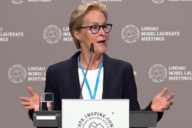You have /5 articles left.
Sign up for a free account or log in.
A recent workforce report for the city of St. Louis found that while there were about 23,000 jobs in science, technology, engineering and mathematics fields advertised last year, there were only about 2,000 job-seekers in those fields. Betsy Cohen, the executive director of the St. Louis Mosaic Project, has an idea for who can fill some of those jobs: the city’s international students.
“We don’t have enough talent, particularly in the STEM fields, so more than ever we need to find the connection between talented international students and employers, to get them engaged and give them the tools,” said Cohen, who’s spearheading a new Global Talent Hiring Program that aims to do just that. The program is multipronged, involving free, one-hour sessions with an immigration lawyer for companies interested in hiring international students; the sharing of “best practices” across international student advising and career service offices at the five participating St. Louis universities; the expansion of an existing mentoring program run by the Regional Business Council to reach a greater number of international students; a recognition program for employers that hire international students as interns or long-term employees; and the creation of courses -- and, ultimately, a certificate program -- for international students focused on skills like networking and interviewing.
A similar initiative in Michigan, the Global Talent Retention Initiative, now in its third year and funded through December with grants from the New Economy Initiative and the Michigan Economic Development Corporation, has developed a series of career conferences for international students in the state and a registry of employers that are open to hiring international students. Athena Trentin, the executive director of the initiative, said staff are currently putting the finishing touches on a registry that will allow international students from across the country (not just Michigan) to create a job-seeker profile and upload a résumé so that Michigan employers looking for, say, a Mandarin speaker with a master’s degree in mechanical engineering can find them.
“We have two goals,” Trentin said. “One is we’ve got the immediate solution to fill jobs; we have an immediate solution for the talent needs in this state, and since immigrants in Michigan in the STEM fields are six times more likely to start their own business than the domestic population here, we’re also investing in Michigan’s future.”
A recent report on the impact of foreign students on metro-level economies from the Brookings Institution emphasized that international students tend to be drawn to STEM fields and recommended that cities should do more to retain international students in the local economy. The report found that 45 percent of international students stayed in the same metropolitan area as their college for the period of post-graduation work authorization known as optional practical training (which lasts for 12 months with the possibility of a 17-month extension for degree-holders in STEM fields) and recommended that cities and colleges educate employers about the visa process, connect foreign students with local employers and advocate for federal immigration reform to increase the number of work visas available to students after the OPT period is up.
Currently, the number of H-1B work visas, the most common route to a green card for international students, is capped at 85,000, and only about a third of H-1Bs granted in 2010 went to former international students, according to the Brookings report. As Neil G. Ruiz writes in that report, there’s been no shortage of Congressional proposals to streamline immigration pathways for international students in recent years, but concerns persist about the possibility of depressing wages and limiting job opportunities for American workers and the proliferation of visa mills masquerading as colleges.
“As we know, the federal government is everything in terms of the number of visas, but I think what cities can do is help educate local employers to utilize the current visa system that we have now,” said Ruiz, the report author and an associate fellow in Brookings’ Metropolitan Policy Program.
To put it differently, it may be a zero-sum game in terms of total number of visas, but individual cities and states can do a better job of playing the game of talent attraction according to the current rule-book. Some parts of the country do a better job than others of retaining international students: the Brookings report notes for example that Seattle, home of Microsoft, retains large numbers of international graduates for OPT placements in the information technology industry, for example. Big tech firms on the West Coast can be expected to have lawyers lined up (or in-house counsel) to help process H-1B applications, while many smaller employers in places like Michigan and Missouri may not have the same infrastructure in place.
Karl Aldrich, assistant director for career services at Saint Louis University, one of five universities participating in the city’s Global Talent Hiring Program, said that preliminary results of a survey of about 400 employers that the university works with show that more than half of respondents don’t know whether their company hires students on OPT or CPT (curricular practical training, a form of work authorization available for current international students), and about 40 percent don’t know whether their company is willing to sponsor employees on H-1B visas.
“Most of the people that are going to respond to the survey are recruiters, which to me says that the individuals who are talking to the students at a career fair or reviewing résumés in a system may be screening out some of those students,” said Aldrich. Aside from the issue of outreach to employers, Aldrich said the career services office at St. Louis sends a monthly newsletter to international students and has office hours in the building that houses the international student office, and is considering adding more workshops and other events specifically tailored for the foreign population.
Yet by definition international students must demonstrate “non-immigrant intent”: that is, they have to convince a U.S. consular officer that they don’t intend to immigrate in order to get a visa to study in the United States in the first place. This is, as Peter Briggs, the director of Michigan State University’s Office for International Students and Scholars, acknowledges, the “elephant in the room.”
“Certainly, it puts us in a box because when we recruit them we have to say they’re coming here temporarily for purposes of study and they have to have a residence in their home country to which they can return. So how can we in good conscience come up with clever ways for them to stay?” Briggs asked.
“I think where we’ve landed with the [Michigan Global Talent Retention Initiative] is we will do much more proactive education with employers about how can you employ an international student with CPT or OPT or even the H-1B and we will do a lot more education for students to figure out how they can navigate the waters of applying for internships.”
“Comprehensive immigration reform isn’t going to happen anytime quickly," Briggs said, "so what is left? What can we really do of substance that is worth it? And I do think that's a lot of much more proactive education of both employers and students."




